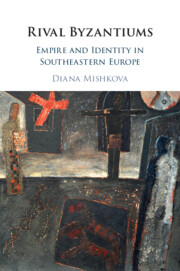Book contents
- Rival Byzantiums
- Rival Byzantiums
- Copyright page
- Contents
- Acknowledgements
- Note on the Text
- Additional material
- Introduction
- Part I On the Road to the Grand Narrative
- Part II Metamorphoses of Byzantium after World War II
- Chapter 6 From Helleno-Christian Civilisation to Roman Nation
- Chapter 7 Towards ‘Slavo-Byzantina’ and ‘Pax Symeonica’
- Chapter 8 How Byzantine Is Serbia?
- Chapter 9 Post-Byzantine Empire or Romanian National State?
- Chapter 10 In the Fold of the ‘Turkish-Islamic Synthesis’
- Epilogue and Conclusion
- References
- Index
Epilogue and Conclusion
from Part II - Metamorphoses of Byzantium after World War II
Published online by Cambridge University Press: 01 December 2022
- Rival Byzantiums
- Rival Byzantiums
- Copyright page
- Contents
- Acknowledgements
- Note on the Text
- Additional material
- Introduction
- Part I On the Road to the Grand Narrative
- Part II Metamorphoses of Byzantium after World War II
- Chapter 6 From Helleno-Christian Civilisation to Roman Nation
- Chapter 7 Towards ‘Slavo-Byzantina’ and ‘Pax Symeonica’
- Chapter 8 How Byzantine Is Serbia?
- Chapter 9 Post-Byzantine Empire or Romanian National State?
- Chapter 10 In the Fold of the ‘Turkish-Islamic Synthesis’
- Epilogue and Conclusion
- References
- Index
Summary
The Epilogue and Conclusion discusses summarily, first, some main changes in the representations of Byzantium and the new directions of Byzantine studies in western Europe and the USA in the last couple of decades. Turning to southeastern Europe, the political caesura of 1989 entailed less, or at least less fast, change in the national historiographic mainstreams than one would have expected, especially as regards medieval history-writing and treatments of Byzantium in the grand national narratives. Yet byzantinists in the region have exerted themselves to diversify their subject matter by including previously unstudied themes. In the Epilogue and Conclusion the new tendencies in the national historiographies, which have impacted the understanding of Byzantium, are broached. The Epilogue and Conclusion outlines the underlying drivers that help explain the diversity of interpretations and instrumentalisations of Byzantium, as well as particular strands of the longue durée such as connections between history and politics, the persistence of the national-Romantic canon, rivalry and cross-fertilisation between historiographical schools as two closely related processes.
Keywords
- Type
- Chapter
- Information
- Rival ByzantiumsEmpire and Identity in Southeastern Europe, pp. 305 - 319Publisher: Cambridge University PressPrint publication year: 2022

